Microstructure and Mechanical Properties of Co-Deposited Ti-Ni Films Prepared by Magnetron Sputtering
Abstract
:1. Introduction
2. Materials and Methods
3. Results and Discussions
3.1. Phase Analysis of Ti-Ni Films
3.2. Surface Morphology and Chemical Composition of Ti-Ni Films
3.3. Cross-Sectional and Fracture Morphology of Ti-Ni Films
3.4. Nano-Indentation Test of Ti-Ni Films
3.5. Scratch Test of Ti-Ni Films
4. Conclusions
Author Contributions
Funding
Institutional Review Board Statement
Informed Consent Statement
Data Availability Statement
Conflicts of Interest
References
- Qi, M.H.; Xu, J.L.; Lai, T.; Huang, J.; Ma, Y.C.; Luo, J.M.; Zheng, Y.F. Novel bioactive Ti-Zn alloys with high strength and low modulus for biomedical applications. J. Alloys Compd. 2023, 931, 167555. [Google Scholar] [CrossRef]
- Romero-Resendiz, L.; Rossi, M.C.; Seguí-Esquembre, C.; Amigó-Borrás, V. Development of a porous Ti-35Nb-5In alloy with low elastic modulus for biomedical implants. J. Mater. Res. Technol. 2023, 22, 1151–1164. [Google Scholar] [CrossRef]
- Wang, W.; Cui, W.; Xiao, Z.; Qin, G. The improved corrosion and wear properties of Ti-Zr based alloys with oxide coating in simulated seawater environment. Surf. Coat. Technol. 2022, 439, 128415. [Google Scholar] [CrossRef]
- Zhang, L.C.; Chen, L.Y. A Review on Biomedical Titanium Alloys: Recent Progress and Prospect. Adv. Eng. Mater. 2019, 21, 1801215. [Google Scholar] [CrossRef] [Green Version]
- Chen, Q.; Thouas, G.A. Metallic Implant biomaterials. Mater. Sci. Eng. R Rep. 2015, 87, 1–57. [Google Scholar] [CrossRef]
- Celesti, C.; Gervasi, T.; Cicero, N.; Giofrè, S.V.; Espro, C.; Piperopoulos, E.; Gabriele, B.; Mancuso, R.; Vecchio, G.L.; Iannazzo, D. Titanium Surface Modification for Implantable Medical Devices with Anti-Bacterial Adhesion Properties. Materials 2022, 15, 3283. [Google Scholar] [CrossRef]
- Chawla, V.; Jayaganthan, R.; Chawla, A.K.; Chandra, R. Morphological study of magnetron sputtered Ti thin films on silicon substrate. Mater. Chem. Phys. 2008, 111, 414–418. [Google Scholar] [CrossRef]
- Jin, Y.; Wu, W.; Li, L.; Chen, J.; Zhang, J.; Zuo, Y.; Fu, J. Effect of sputtering power on surface topography of dc magnetron sputtered Ti thin films observed by AFM. Appl. Sur. Sci. 2009, 255, 4673–4679. [Google Scholar]
- Liu, Y.L.; Fang, L.I.U.; Qian, W.U.; Chen, A.Y.; Xiang, L.I.; Deng, P.A.N. Effect of bias voltage on microstructure and nanomechanical properties of Ti films. Trans. Nonferrous Met. Soc. China 2014, 24, 2870–2876. [Google Scholar] [CrossRef]
- Godfroid, T.; Gouttebaron, R.; Dauchot, J.P.; Leclere, P.; Lazzaroni, R.; Hecq, M. Growth of ultrathin Ti films deposited on SnO2 by magnetron sputtering. Thin Solid Film. 2003, 437, 57–62. [Google Scholar] [CrossRef]
- Chawla, V.; Jayaganthan, R.; Chawla, A.K.; Chandra, R. Microstructural characterizations of magnetron sputtered Ti films on glass substrate. J. Mater. Process. Technol. 2009, 209, 3444–3451. [Google Scholar] [CrossRef]
- Moskovkin, P.; Maszl, C.; Schierholz, R.; Breilmann, W.; Petersen, J.; Pflug, A.; Muller, J.; Raza, M.; Konstantinidis, S.; von Keudell, A.; et al. Link between plasma properties with morphological, structural and mechanical properties of thin Ti films deposited by high power impulse magnetron sputtering. Surf. Coat. Technol. 2021, 418, 127235. [Google Scholar] [CrossRef]
- Duan, R.; Li, S.; Cai, B.; Zhu, W.; Ren, F.; Attallah, M.M. A high strength and low modulus metastable β Ti-12Mo-6Zr-2Fe alloy fabricated by laser powder bed fusion in-situ alloying. Addit. Manuf. 2021, 48, 101708. [Google Scholar] [CrossRef]
- Prakash, C.; Singh, S.; Ramakrishna, S.; Królczyk, G.; Le, C.H. Microwave sintering of porous Ti–Nb-HA composite with high strength and enhanced bioactivity for implant applications. J. Alloys Compd. 2020, 824, 153774. [Google Scholar] [CrossRef]
- Markhoff, J.; Weinmann, M.; Schulze, C.; Bader, R. Influence of different grained powders and pellets made of Niobium and Ti-42Nb on human cell viability. Mater. Sci. Eng. C 2017, 73, 756–766. [Google Scholar] [CrossRef]
- Liu, L.; Li, W.; Sun, H.; Wang, G. Effects of Ti Target Purity and Microstructure on Deposition Rate, Microstructure and Properties of Ti Films. Materials 2022, 15, 2661. [Google Scholar] [CrossRef]
- Cai, K.; Müller, M.; Bossert, J.; Rechtenbach, A.; Jandt, K.D. Surface structure and composition of flat titanium thin films as a function of film thickness and evaporation rate. Appl. Surf. Sci. 2005, 250, 252–267. [Google Scholar] [CrossRef]
- Oya, T.; Kusano, E. Effects of radio-frequency plasma on structure and properties in Ti film deposition by dc and pulsed dc magnetron sputtering. Thin Solid Film. 2009, 517, 5837–5843. [Google Scholar] [CrossRef]
- Bălţatu, M.S.; Vizureanu, P.; Goanţă, V.; Ţugui, C.A.; Voiculescu, I. Mechanical Tests for Ti-Based Alloys as New Medical Materials; IOP Publishing: Bristol, UK, 2019; Volume 572, p. 012029. [Google Scholar]
- Hsu, H.C.; Wu, S.C.; Chiang, T.Y.; Ho, W.F. Structure and grindability of dental Ti-Cr alloys. J. Alloys Compd. 2009, 476, 817–825. [Google Scholar] [CrossRef]
- Xu, W.; Chen, M.; Lu, X.; Zhang, D.W.; Singh, H.P.; Jian-shu, Y.; Pan, Y.; Qu, X.H.; Liu, C.Z. Effects of Mo content on corrosion and tribocorrosion behaviours of Ti-Mo orthopaedic alloys fabricated by powder metallurgy. Corros. Sci. 2020, 168, 108557. [Google Scholar] [CrossRef]
- Asl, M.S.; Delbari, S.A.; Azadbeh, M.; Namini, A.S.; Mehrabian, M.; Nguyen, V.H.; Van Le, Q.; Shokouhimehr, M.; Mohammadi, M. Nanoindentational and conventional mechanical properties of spark plasma sintered Ti-Mo alloys. J. Mater. Res. Technol. 2020, 9, 10647–10658. [Google Scholar]
- Lee, C.M.; Ju, C.P.; Chern Lin, J.H. Structure-property relationship of cast Ti-Nb alloys. J. Oral. Rehabil. 2022, 29, 314–322. [Google Scholar] [CrossRef]
- Dos Santos, R.F.; Rossi, M.C.; Vidilli, A.L.; Borrás, V.A.; Afonso, C.R.M. Assessment of β stabilizers additions on microstructure and properties of as-cast β Ti–Nb based alloys. J. Mater. Res. Technol. 2023, 22, 3511–3524. [Google Scholar] [CrossRef]
- Fikeni, L.; Annan, K.A.; Mutombo, K.; Machaka, R. Effect of Nb content on the microstructure and mechanical properties of binary Ti-Nb alloys. Mater. Today 2021, 38, 913–917. [Google Scholar] [CrossRef]
- Photiou, D.; Panagiotopoulos, N.T.; Koutsokeras, L.; Evangelakis, G.A.; Constantinides, G. Microstructure and nanomechanical properties of magnetron sputtered Ti-Nb films. Surf. Coat. Technol. 2016, 302, 310–319. [Google Scholar] [CrossRef]
- Zhang, F.; Li, C.; Yan, M.; He, J.; Yang, Y.; Yin, F. Microstructure and nanomechanical properties of co-deposited Ti-Cr films prepared by magnetron sputtering. Surf. Coat. Technol. 2017, 325, 636–642. [Google Scholar] [CrossRef]
- Liu, G.; Yang, Y.; Luo, X.; Huang, B.; Li, P. The phase, morphology and surface characterization of Ti–Mo alloy films prepared by magnetron sputtering. RSC Adv. 2017, 7, 52595–52603. [Google Scholar] [CrossRef] [Green Version]
- Lopes, C.; Vieira, M.; Borges, J.; Fernandes, J.; Rodrigues, M.S.; Alves, E.; Barradas, N.P.; Apreutesei, M.; Steyer, P.; Tavares, C.J.; et al. Multifunctional Ti–Me (Me = Al, Cu) thin film systems for biomedical sensing devices. Vacuum 2015, 122, 353–359. [Google Scholar] [CrossRef]
- Stranak, V.; Wulff, H.; Rebl, H.; Zietz, C.; Arndt, K.; Bogdanowicz, R.; Nebe, B.; Bader, R.; Podbielski, A.; Hubicka, Z.; et al. Deposition of thin titanium–copper films with antimicrobial effect by advanced magnetron sputtering methods. Mater. Sci. Eng. C 2011, 31, 1512–1519. [Google Scholar] [CrossRef]
- Kobata, J.; Miura, K.I.; Amiya, K.; Fukuda, Y.; Saotome, Y. Nanoimprinting of Ti–Cu-based thin-film metallic glasses deposited by unbalanced magnetron sputtering. J. Alloys Compd. 2017, 707, 132–136. [Google Scholar] [CrossRef]
- Wojcieszak, D.; Mazur, M.; Kaczmarek, D.; Mazur, P.; Szponar, B.; Domaradzki, J.; Kepinski, L. Influence of the surface properties on bactericidal and fungicidal activity of magnetron sputtered Ti-Ag and Nb-Ag thin films. Mater. Sci. Eng. C 2016, 62, 86–95. [Google Scholar] [CrossRef] [PubMed]
- Frenzel, J.; Wieczorek, A.; Opahle, I.; Maaß, B.; Drautz, R.; Eggeler, G. On the effect of alloy composition on martensite start temperatures and latent heats in Ni–Ti-based shape memory alloys. Acta Mater. 2015, 90, 213–231. [Google Scholar] [CrossRef]
- Li, B.Y.; Rong, L.J.; Li, Y.Y.; Gjunter, V.E. Electric resistance phenomena in porous Ni-Ti shape-memory alloys produced by SHS. Scr. Mater. 2001, 44, 823–827. [Google Scholar] [CrossRef]
- Yi, X.; Wang, H.; Sun, K.; Sun, B.; Wu, L.; Meng, X.; Gao, Z.; Cai, W. Tailoring of microstructure and martensitic transformation of nanocrystalline Ti–Ni-Hf shape memory thin film. Prog. Nat. Sci.-Mater. 2021, 31, 288–295. [Google Scholar] [CrossRef]
- Li, J.; Sun, K.; Li, X.; Meng, X.; Cai, W. High damping performances over wide temperature range in the B doped Ti-Ni shape memory alloys. Mater. Lett. 2023, 330, 133245. [Google Scholar] [CrossRef]
- Karki, V.; Debnath, A.K.; Kumar, S.; Bhattacharya, D. Synthesis of co-sputter deposited Ni–Ti thin alloy films and their compositional characterization using depth sensitive techniques. Thin Solid Film. 2020, 697, 137800. [Google Scholar] [CrossRef]
- Ren, D.C.; Zhang, H.B.; Liu, Y.J.; Li, S.J.; Jin, W.; Yang, R.; Zhang, L.C. Zhang, Microstructure and properties of equiatomic Ti–Ni alloy fabricated by selective laser melting. Mater. Sci. Eng. A 2020, 771, 138586. [Google Scholar] [CrossRef]
- Macías, H.A.; Yate, L.; Coy, L.E.; Olaya, J.J.; Aperador, W. Effect of nitrogen flow ratio on microstructure, mechanical and tribological properties of TiWSiNx thin film deposited by magnetron co-sputtering. Appl. Surf. Sci. 2018, 456, 445–456. [Google Scholar] [CrossRef]
- Kabir, M.S.; Munroe, P.; Zhou, Z.; Xie, Z. Study of the structure, properties, scratch resistance and deformation behaviour of graded Cr-CrN-Cr(1-x)AlxN coatings. Ceram. Int. 2018, 44, 11364–11373. [Google Scholar] [CrossRef]
- Sha, C.; Zhou, Z.; Xie, Z.; Munroe, P. Scratch response and tribological behaviour of CrAlNiN coatings deposited by closed field unbalanced magnetron sputtering system. Surf. Coat. Technol. 2019, 367, 30–40. [Google Scholar] [CrossRef]
- Heinke, W.; Leyland, A.; Matthews, A.; Berg, G.; Friedrich, C.; Broszeit, E. Evaluation of PVD nitride coatings, using impact, scratch and Rockwell-C adhesion tests. Thin Solid Film. 1995, 270, 431–438. [Google Scholar] [CrossRef]
- Kim, H.K.; La, J.H.; Kim, K.S.; Lee, S.Y. The effects of the H/E ratio of various Cr–N interlayers on the adhesion strength of CrZrN coatings on tungsten carbide substrates. Surf. Coat. Technol. 2015, 284, 230–234. [Google Scholar] [CrossRef]
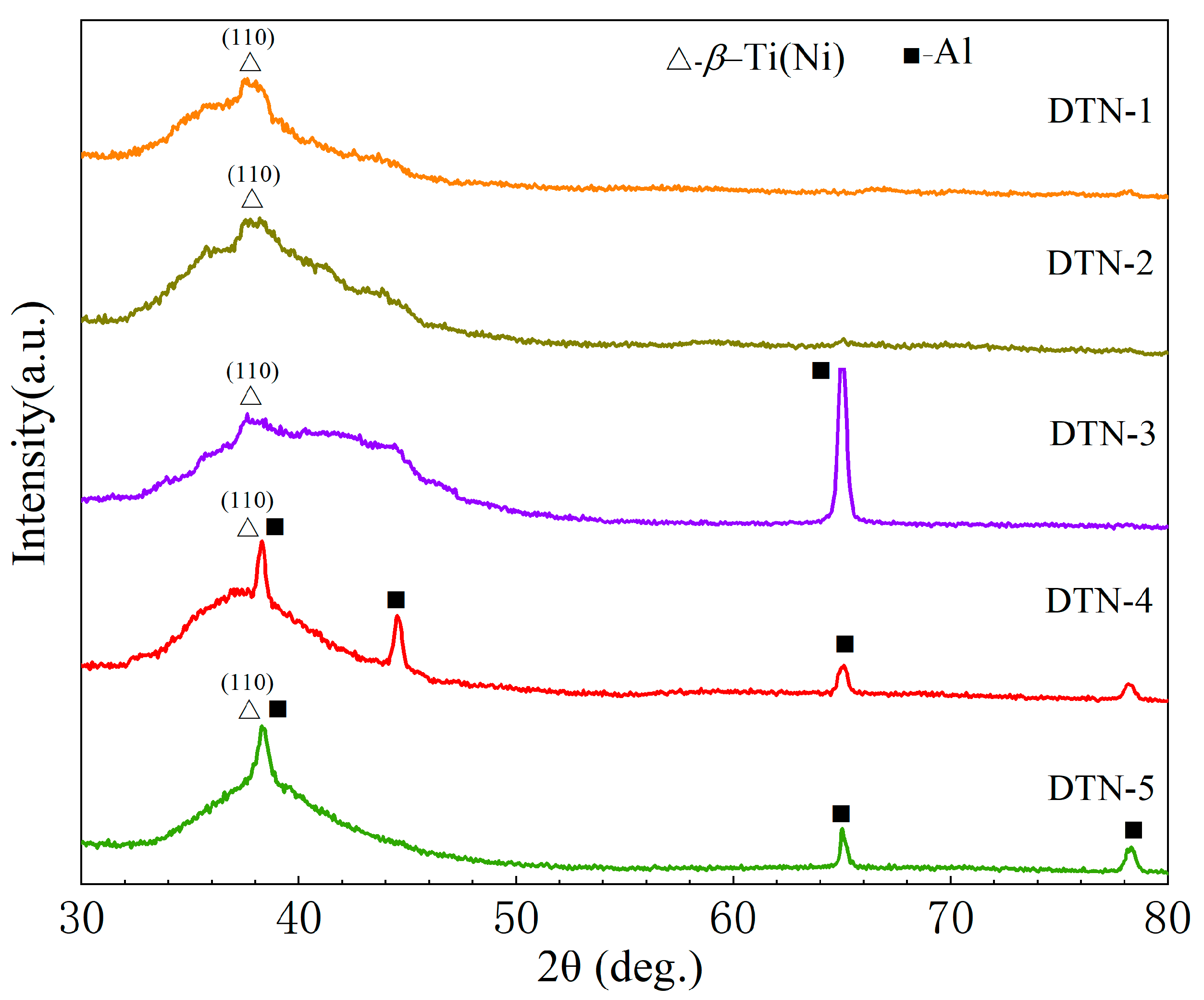


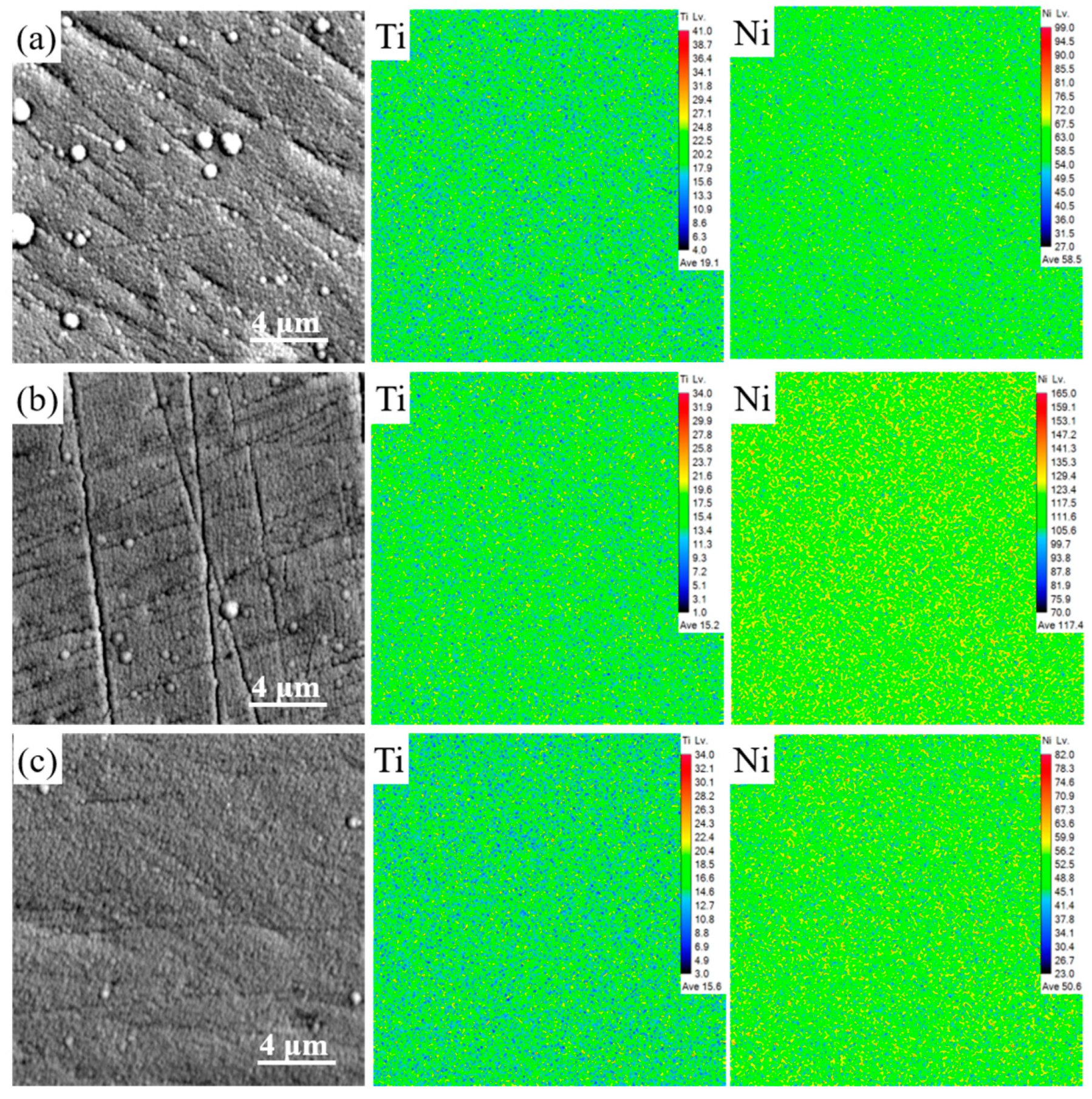
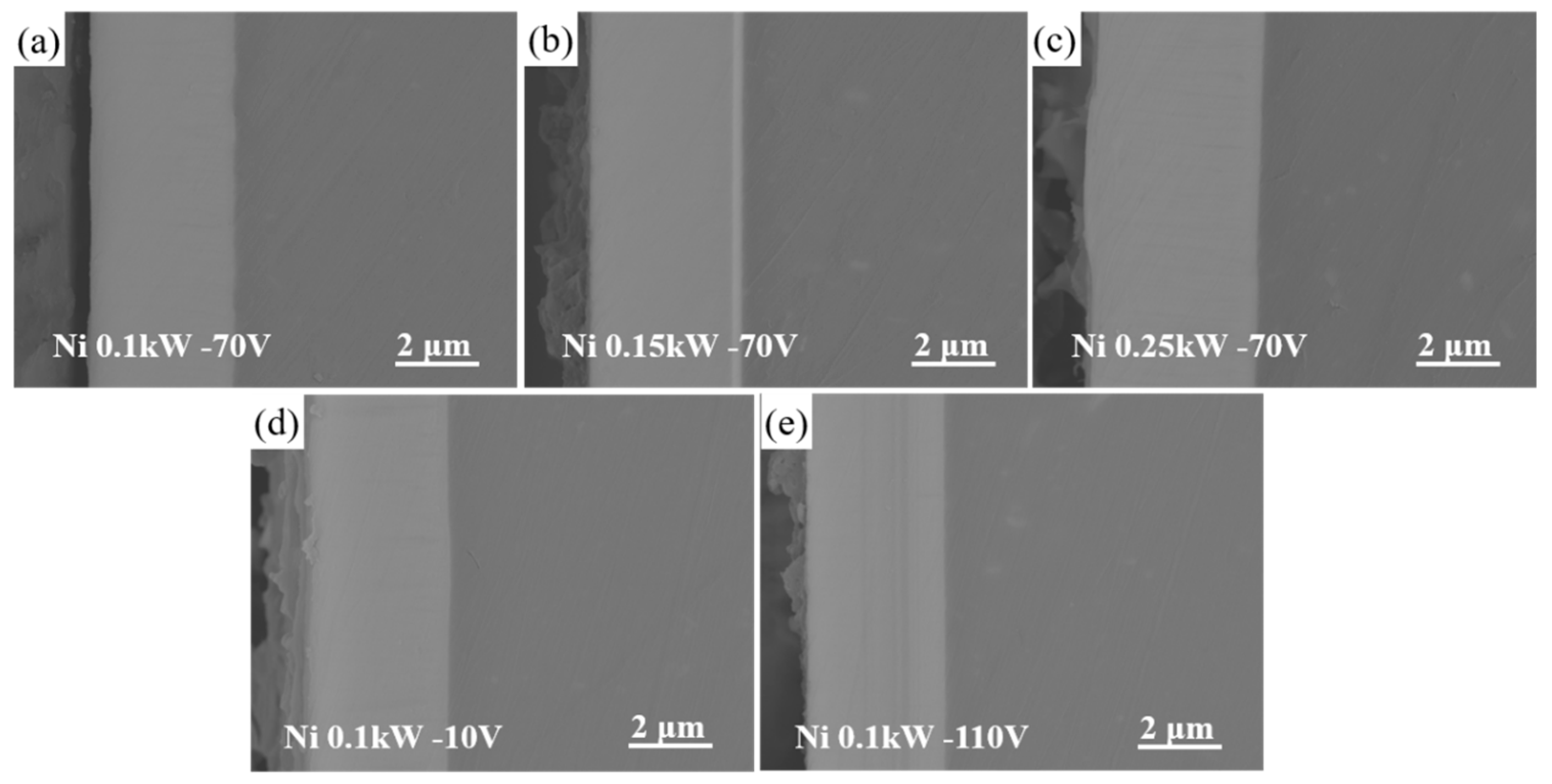
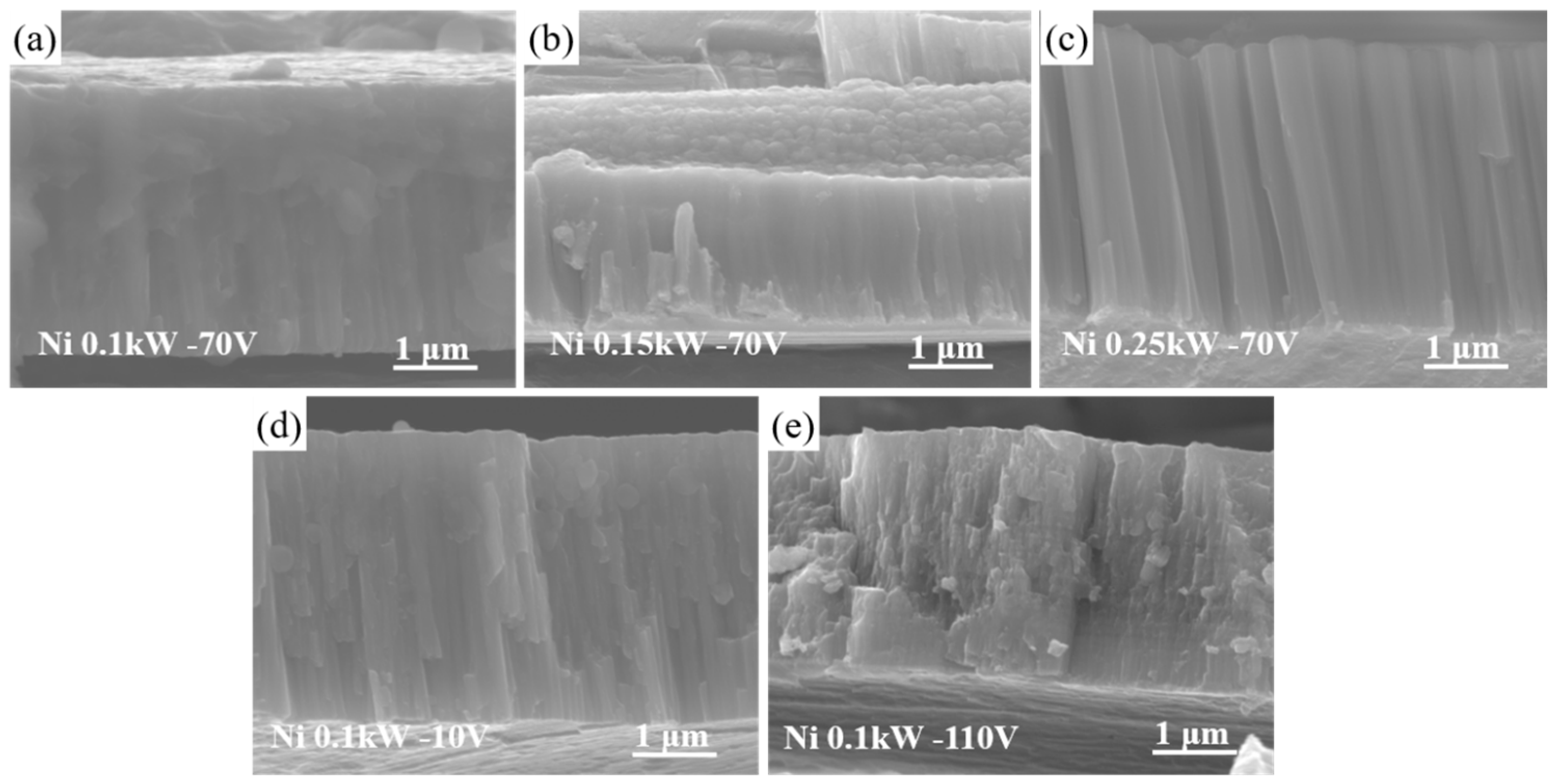
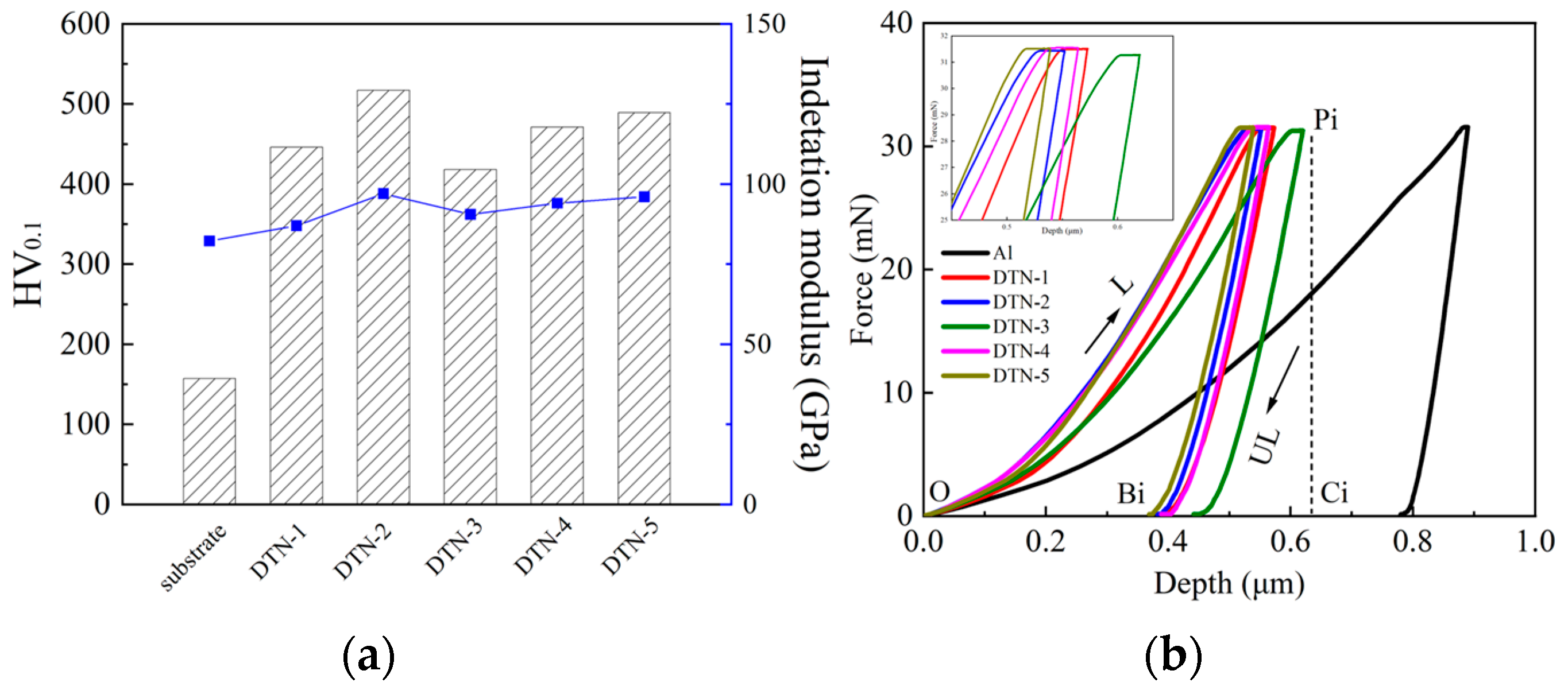
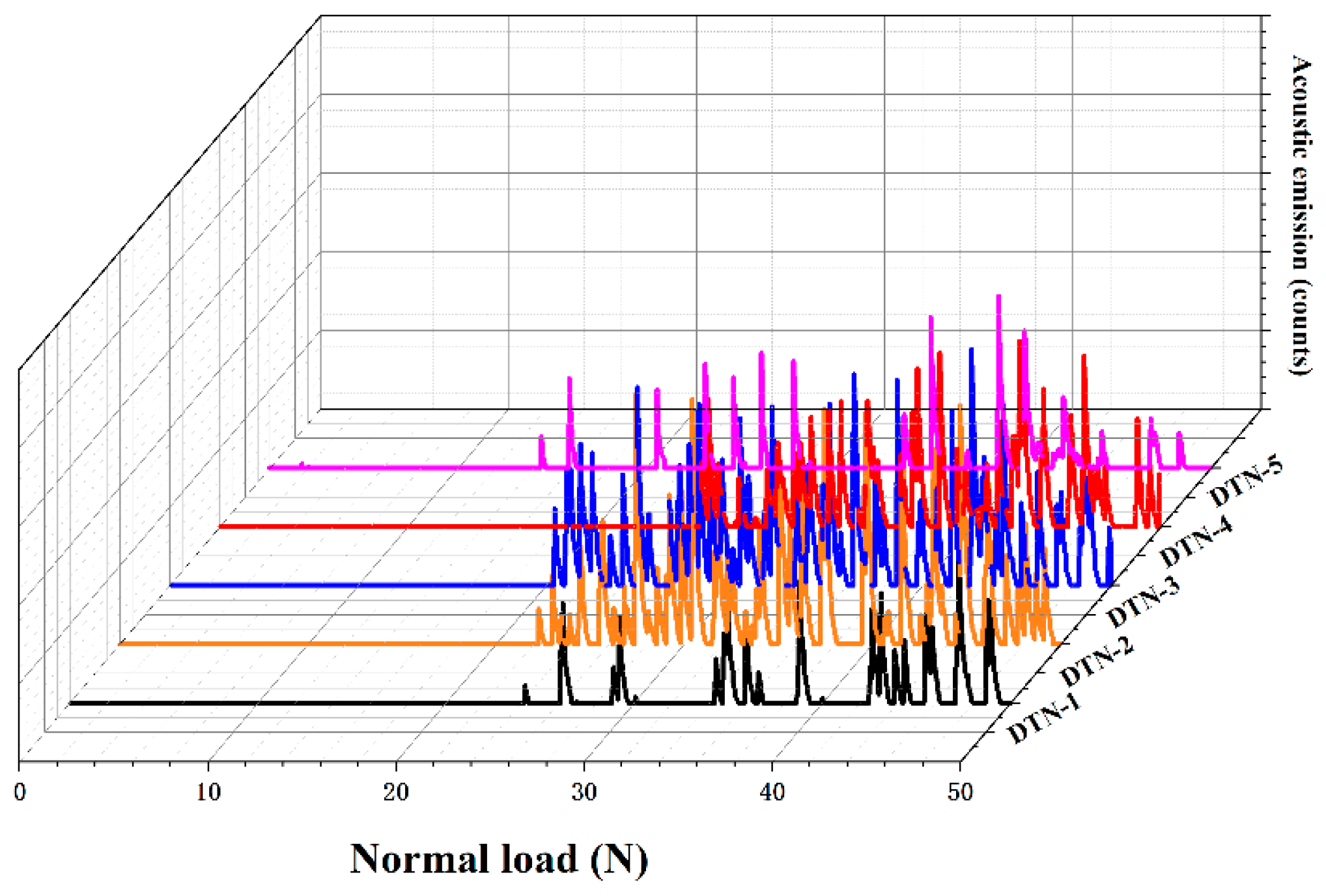

| Process Parameter | Unit | Value |
|---|---|---|
| Background pressure | Pa | 4 × 10−3 |
| Argon flux | sccm | 16 |
| Ti target power | kW | 1.5 |
| Ni target power | kW | 0.1, 0.15, 0.25 |
| Bias voltage | V | −10, −70, −110 |
| Sputtering time | min | 120 |
| Sputtering pressure | Pa | 0.2–0.3 |
| Target-substrate distance | mm | 70 |
| Films/Elements | Ti (at. %) | Ni (at. %) |
|---|---|---|
| DTN-1 | 83.5 | 16.5 |
| DTN-2 | 78.0 | 22.0 |
| DTN-3 | 66.5 | 33.5 |
| DTN-4 | 83.4 | 16.6 |
| DTN-5 | 83.7 | 16.3 |
| Sample | H (GPa) | E (GPa) | H/E (×10−2) | H3/E2 (×10−2) | Wt (nJ) | Wp (nJ) | ηp |
|---|---|---|---|---|---|---|---|
| 2024Al | 1.57 | 82 | 1.91 | 0.05 | 10.65 | 9.3 | 0.87 |
| DTN-1 | 4.45 | 87 | 5.12 | 1.17 | 6.17 | 4.59 | 0.69 |
| DTN-2 | 5.17 | 97.6 | 5.29 | 1.14 | 6.4 | 5.03 | 0.79 |
| DTN-3 | 4.18 | 90.5 | 4.62 | 0.89 | 7.47 | 5.59 | 0.75 |
| DTN-4 | 4.71 | 94.5 | 4.98 | 1.17 | 7.09 | 5.37 | 0.76 |
| DTN-5 | 4.89 | 96 | 5.10 | 1.27 | 6.11 | 4.69 | 0.77 |
| Sample | Critical Load (N) |
| DTN-1 | 26.1 |
| DTN-2 | 22.2 |
| DTN-3 | 20.5 |
| DTN-4 | 25.5 |
| DTN-5 | 14.4 |
Disclaimer/Publisher’s Note: The statements, opinions and data contained in all publications are solely those of the individual author(s) and contributor(s) and not of MDPI and/or the editor(s). MDPI and/or the editor(s) disclaim responsibility for any injury to people or property resulting from any ideas, methods, instructions or products referred to in the content. |
© 2023 by the authors. Licensee MDPI, Basel, Switzerland. This article is an open access article distributed under the terms and conditions of the Creative Commons Attribution (CC BY) license (https://creativecommons.org/licenses/by/4.0/).
Share and Cite
Zhang, X.; Ding, Y.; Ma, H.; Zhao, R.; Wang, L.; Zhang, F. Microstructure and Mechanical Properties of Co-Deposited Ti-Ni Films Prepared by Magnetron Sputtering. Coatings 2023, 13, 524. https://doi.org/10.3390/coatings13030524
Zhang X, Ding Y, Ma H, Zhao R, Wang L, Zhang F. Microstructure and Mechanical Properties of Co-Deposited Ti-Ni Films Prepared by Magnetron Sputtering. Coatings. 2023; 13(3):524. https://doi.org/10.3390/coatings13030524
Chicago/Turabian StyleZhang, Xiaolin, Yi Ding, Honglu Ma, Ruibin Zhao, Liangquan Wang, and Fanyong Zhang. 2023. "Microstructure and Mechanical Properties of Co-Deposited Ti-Ni Films Prepared by Magnetron Sputtering" Coatings 13, no. 3: 524. https://doi.org/10.3390/coatings13030524





